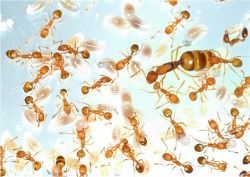In many ant species, colonies form trails which connect the nest to the surrounding environment. These trail systems are an important example of collective organization and are tractable for experimental study. They are also an example of the use of networks by insect societies, and are important in understanding the ecology and success of ants. But they are also relevant in the wider context of network research; many biological and technological networks (e.g., vascular and nervous systems, roads, electricity, internet) face similar dynamic organizational challenges in the transport of material and information.
 A queen Pharaoh's ant is much larger than her smaller workers. Image by Francis Ratnieks.
A queen Pharaoh's ant is much larger than her smaller workers. Image by Francis Ratnieks.
I am working on mathematical modelling of these behaviours with my colleagues David Waxman (Fudan University, Shanghai http://www.dwaxman.com/ ) and Pierre Nouvellet (Imperial College). We study the establishment and modification of trail networks as the emergent product of the actions of many individuals, by digitally recording the entire foraging environment, and the pathways of each individual ant under controlled and reproducible conditions. This allows efficient extraction of very large amounts of data. It is possible to recreate the actual trails followed by individual ants by sampling at 8 frames per second. The data collected in this way have been used to provide mathematical descriptions of ant-foraging patterns. In particular, we have produced a mathematical model, where individual ants independently undergo a random walk with some tendency to maintain direction. This leads to a compact mathematical description of ant trajectories in which modelled and actual trajectories have near identical statistical properties and predictions for new situations can be made.
The banner picture shows ant trails visualized via computer analysis of digital video to show areas of high (dark) and low (light) ant density. (a) Worker M. pharaonis enter virgin territory via a bridge (red) and establish trails, shown at three times after initial entry. Sucrose was introduced after 70 minutes and syrup collecting is evident in a switch in the pattern of trails. (b) The number of ants (counted every 2 minutes) grows during exploration, but drops sharply when sucrose is introduced and ants return to the nest with it.


